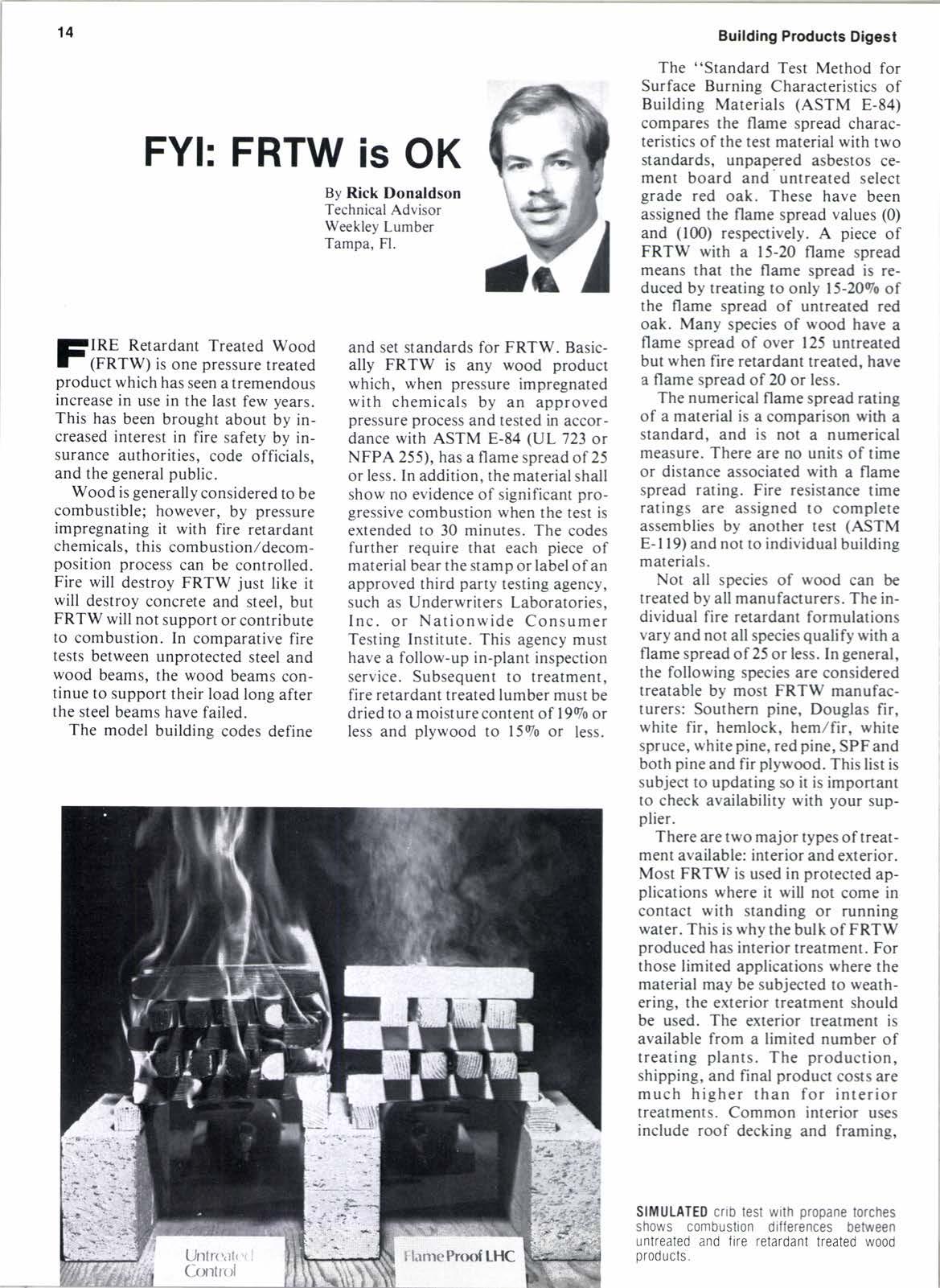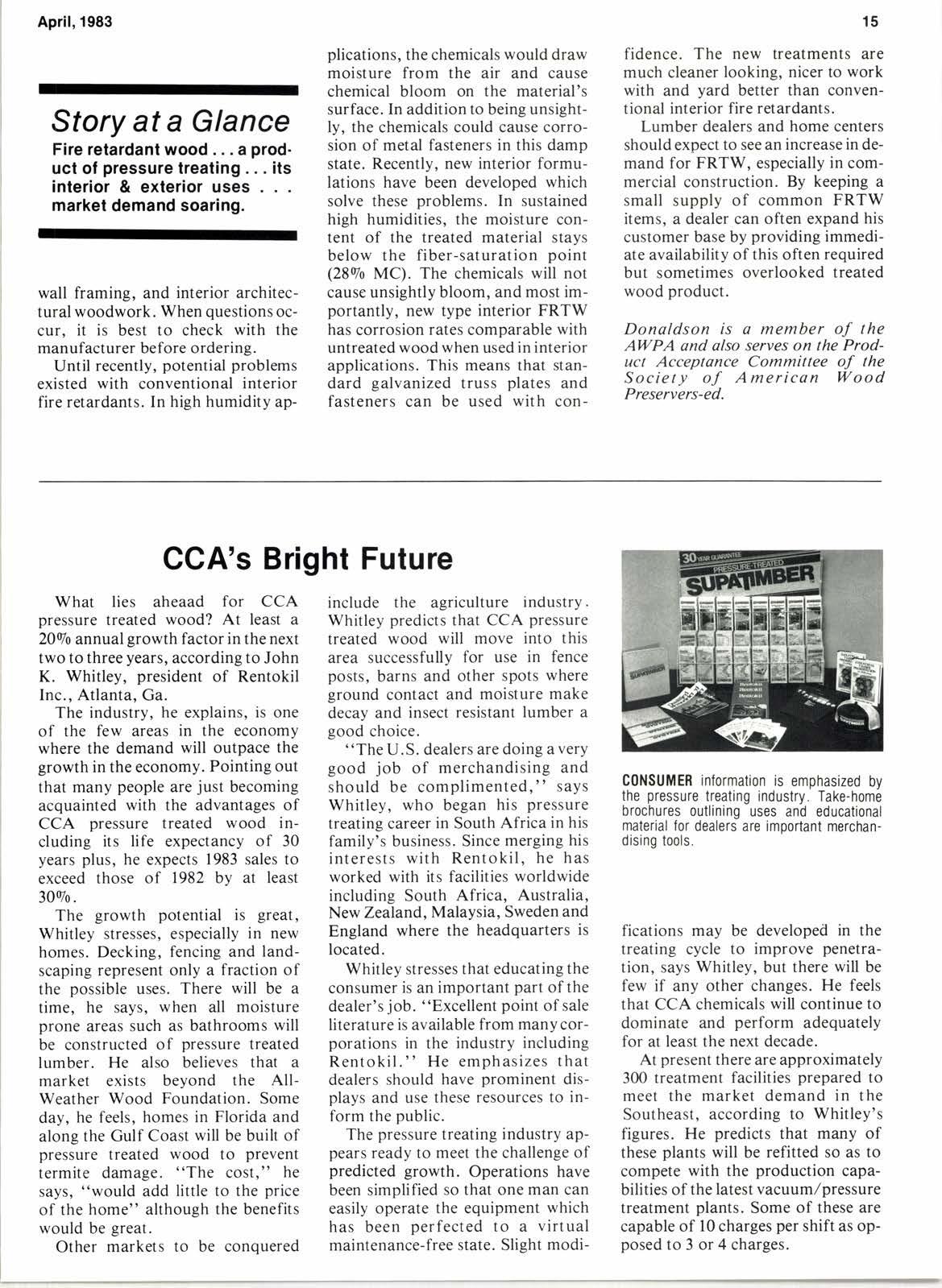
5 minute read
FYI: FRTW is OK
By Rick Donaldson Technical Advisor Weekley Lumber Tampa, Fl.
EIRE Retardant Treated Wood I (FRTW) is one pressure treated product which has seen a tremendous increase in use in the last few years. This has been brought about by increased interest in fire safety by insurance authorities, code officials, and the general public
Wood is generally considered to be combustible; however, by pressure impregnating it with fire retardant chemicals. this combustion,/decomposition process can be controlled. Fire will destroy FRTW just like it will destroy concrete and steel, but FRTW will not support or contribute to combustion. In comparative fire tests between unprotected steel and wood beams. the wood beams continue to support their load long after the steel beams have failed.
The model building codes define and set standards for FRTW. Basically FRTW is any wood product which, when pressure impregnated with chemicals by an approved pressure process and tested in accordance with ASTM E-84 (UL 723 or NFPA 255), has a flame spread of 25 or less. In addition. the material shall show no evidence of significant progressive combustion when the test is extended to 30 minutes. The codes further require that each piece of material bear the stamp or label of an approved third party testing agency, such as Underwriters Laboratories, Inc. or Nationwide Consumer Testing Institute. This agency must have a follow-up in-plant inspection service. Subsequent to treatment, fire retardant treated lumber must be dried to a moisture content of l99o or less and plywood to l59o or less.
The "Standard Test Method for Surface Burning Characteristics of Building Materials (ASTM E-84) compares the flame spread characteristics of the test material with two standards, unpapered asbestos cement board and untreated select grade red oak. These have been assigned the flame spread values (0) and (100) respectively. A piece of FRTW with a 15-20 flame spread means that the flame spread is reduced by treating to only l5-209o of the flame spread of untreated red oak. Many species of wood have a flame spread of over 125 untreated but when fire retardant treated, have a flame spread of 20 or less.
The numerical flame spread rating of a material is a comparison with a standard, and is not a numerical measure. There are no units of time or distance associated with a flame spread rating. Fire resistance time ratings are assigned to complete assemblies by another test (ASTM E-l l9) and not to individual building materials.
Not all species of wood can be treated by all manufacturers. The individual fire retardant formulations vary and not all species qualify with a flame spread of 25 or less. In general, the following species are considered treatable by most FRTW manufacturers: Southern pine, Douglas fir, white fir, hemlock, hem/fir, white spruce, white pine, red pine, SPF and both pine and fir plywood. This list is subject to updating so it is important to check availability with your supplier.
There are two major types of treatment available: interior and exterior. Most FRTW is used in protected applications where it will not come in contact with standing or running water. This is why the bulk of FRTW produced has interior treatment. For those limited applications where the material may be subjected to weathering, the exterior treatment should be used. The exterior treatment is available from a limited number of treating plants. The production, shipping, and final product costs are much higher than for interior treatments. Common interior uses include roof decking and framing,
Story at a Glance
Fire retardant wood . . . a product of pressure treating .. its interior & exterior uses market demand soaring. wall framing, and interior architectural woodwork. When questions occur, it is best to check with the manufacturer before ordering.
Until recently, potential problems existed with conventional interior fire retardants. In high humidity ap- plications, the chemicals would draw moisture from the air and cause chemical bloom on the material's surface. In addition to being unsightly, the chemicals could cause corrosion of metal fasteners in this damp state. Recently, new interior formulations have been developed which solve these problems. In sustained high humidities, the moisture content of the treated material stays below the fiber-saturation point (2890 MC). The chemicals will not cause unsightly bloom, and most importantly, new type interior FRTW has corrosion rates comparable with untreated wood when used in interior applications. This means that standard galvanized truss plates and fasteners can be used with con-
GCA's Bright Future
What lies aheaad for CCA pressure treated wood? At least a 2090 annual growth factor in the next two to three years, according to John K. Whitley, president of Rentokil Inc., Atlanta, Ga.
The industry, he explains, is one of the few areas in the economy where the demand will outpace the growth in the economy. Pointing out that many people are just becoming acquainted with the advantages of CCA pressure treated wood including its life expectancy of 30 years plus, he expects 1983 sales to exceed those of 1982 by at least 3090.
The growth potential is great, Whitley stresses, especially in new homes. Decking, fencing and landscaping represent only a fraction of the possible uses. There will be a time, he says, when all moisture prone areas such as bathrooms will be constructed of pressure treated lumber. He also believes that a market exists beyond the AllWeather Wood Foundation. Some day, he feels, homes in Florida and along the Gulf Coast will be built of pressure treated wood to prevent termite damage. "The cost," he says, "would add little to the price of the home" although the benefits would be great.
Other markets to be conquered
include the agriculture industry. Whitley predicts that CCA pressure treated wood will move into this area successfully for use in fence posts, barns and other spots where ground contact and moisture make decay and insect resistant lumber a good choice.
"The U.S. dealers are doing a very good job of merchandising and should be complimented," says Whitley, who began his pressure treating career in South Africa in his family's business. Since merging his interests with Rentokil, he has worked with its facilities worldwide including South Africa, Australia, New Zealand, Malaysia, Sweden and England where the headquarters is located.
Whitley stresses that educating the consumer is an important part of the dealer's job. "Excellent point of sale literature is available from many corporations in the industry including Rentokil." He emphasizes that dealers should have prominent displays and use these resources to inform the public.
The pressure treating industry appears ready to meet the challenge of predicted growth. Operations have been simplified so that one man can easily operate the equipment which has been perfected to a virtual maintenance-free state. Slisht modi- fidence. The new treatments are much cleaner looking, nicer to work with and yard better than conventional interior fire retardants. fications may be developed in the treating cycle to improve penetration, says Whitley, but there will be few if any other changes. He feels that CCA chemicals will continue to dominate and perform adequately for at least the next decade.
Lumber dealers and home centers should expect to see an increase in demand for FRTW, especially in commercial construction. By keeping a small supply of common FRTW items, a dealer can often expand his customer base by providing immediate availability of this often required but sometimes overlooked treated wood product.
Donaldson is a member of the AWPA and qlso serves on the Product Acceptqnce Committee of the Society o-f American Wood Preservers-ed.
At present there are approximately 300 treatment facilities prepared to meet the market demand in the Southeast, according to Whitley's figures. He predicts that many of these plants will be refitted so as to compete with the production capabilities of the latest vacuum/pressure treatment plants. Some of these are capable of l0 charges per shift as opposed to 3 or 4 charges.











